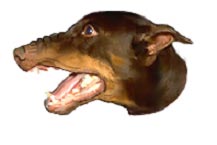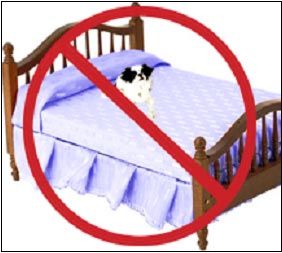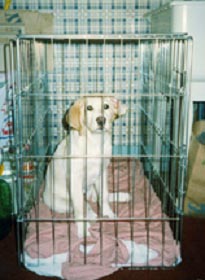|
What
does "dominance hierarchy"
mean?
 The
concept of dominance hierarchy
is used when describing social
relationships within groups
of animals. Animals that live
in groups do so because of the
advantages. These include cooperative
raising of the young, ease of
obtaining food and defense against
predators. Since group members
offer benefits to each other,
it is counter-productive to
fight among members and risk
injury. Therefore, communication
and an understanding of how
to share resources is essential.
Resources are usually allocated
to the strongest members first.
Those at the top get things
such as food, resting-places,
mates and favored possessions
preferentially over lower ranking
individuals. This has been termed
"dominance" hierarchy.
The rank of an individual is
determined by such factors as
genetics, which individual was
first on the territory, age,
results of competitive encounters,
and the competition for resources. The
concept of dominance hierarchy
is used when describing social
relationships within groups
of animals. Animals that live
in groups do so because of the
advantages. These include cooperative
raising of the young, ease of
obtaining food and defense against
predators. Since group members
offer benefits to each other,
it is counter-productive to
fight among members and risk
injury. Therefore, communication
and an understanding of how
to share resources is essential.
Resources are usually allocated
to the strongest members first.
Those at the top get things
such as food, resting-places,
mates and favored possessions
preferentially over lower ranking
individuals. This has been termed
"dominance" hierarchy.
The rank of an individual is
determined by such factors as
genetics, which individual was
first on the territory, age,
results of competitive encounters,
and the competition for resources.
In
an encounter where one animal
acts "dominant"
there needs to be another who
acts subordinate or fighting
will occur. Subordinate or submissive
behaviors in dogs include looking
away, or lowered head, body,
tail and ears. Extreme submission
is shown by crouching down and
rolling over and exposing the
abdomen. Note that a dominance
or pack hierarchy will develop
in a group of dogs, but that
dominance or leadership refers
to the relative relationship
of two individuals. Dominance
is the quality of a relationship,
not of an individual. Whether
a dog is subordinate to one
dog or person, has little bearing
on whether that dog is subordinate
to another person or dog.
Often an alternate view is proposed
which uses the premise that
hierarchies are maintained by
the deference of individuals,
not by dominant actions.
How
does this apply to dogs in human
households?
Dogs
have evolved from wolves, which
live in social groups, so the
domestic dog is evolutionarily
prepared to live in a group.
Each member of this social group
develops a relationship with
every other member of the group
and is either dominant or subordinate
to that individual. You may
have little control over which
dog in your home becomes leader
in regards to the other dogs
in the home. Most dogs work
things out between themselves.
For aggression between dogs
in the household please see
our handout on sibling rivalry.
However,
each human in the family must
be a leader in his or her relationship
with the dog. Yet humans do
not communicate with the exactly
the same body language, postures,
signals and actions as do dogs.
Therefore, relationships that
develop with humans are not
entirely analogous to those
that develop between dogs. Human
leadership and control must
be achieved through actions,
training and handling that teach
the dog to defer to the owner
to receive rewards. A leadership
program in dogs teaches the
dog that rewards are earned
for compliance and obedience,
that handling and restraint
on the part of the owners are
to be tolerated and enjoyed,
that rewards cannot be obtained
on demand and that the owner
initiates favored activities
such as play and walks. Confrontational
techniques and those that use
physical restraint and handling
to gain control should be avoided
as they may lead to defensive
and fearful responses. When
a dog has access to all things
on demand or when it desires
them (food, resting places on
furniture and beds, owner attention
at any time, territorial displays
at doors and windows) the dog
may assume it is dominant to
the humans due to what it perceives
as owner deference. If the dog
perceives itself as the "leader"
in its relationship with the
humans in the home , it may
respond with aggressive displays,
threats and actions when challenged
for control of its access to
critical resources (food, toys,
personal space). With the responsibility
of being leader these dogs may
also be more possessive, protective,
and anxious than dogs that have
the "comfort" of
knowing that another (owner
or other dog) is in charge and
in control of their pack or
household. Keep in mind, a dog
may assume a dominant role when
it perceives that no one else
in the group has taken that
position rather than it having
a strong desire to "control".
In
many cases of social status
or dominance aggression there
are aspects of arousal, conflict
and anxiety that are key factors
in the aggression. When dogs
challenge their owners to maintain
a favored resource (e.g. sleeping
area, toy, or attention of a
family member) the problem may
be aggravated by the owner's
reaction (e.g. withdrawal that
 reinforces
the behavior or threats, punishment,
and anxiety which increases
the dog's fear, defensiveness,
and anxiety) and over time learns
that aggressive behavior results
in a successful outcome for
the dog. reinforces
the behavior or threats, punishment,
and anxiety which increases
the dog's fear, defensiveness,
and anxiety) and over time learns
that aggressive behavior results
in a successful outcome for
the dog.
How can I prevent my dog from
becoming in control?
It
is important that owners set
themselves up as leaders very
early in their relationship
with their dog. Most dogs readily
obey but some require a fair
amount of patience and consistency
since they may be genetically
more likely to challenge and
resist. Ask for our handouts
on basic training and taking
charge. Becoming the leader
does not imply harshness or
punishment, but control of resources
and behavior. This is accomplished
with training and supervision.
The individual temperament and
genetic predisposition of the
puppy will determine the methods
needed by the owner to become
the leader. Equally important
is to recognize deference when
it occurs. When your dog looks
away, lowers its head or avoids,
especially when you are reprimanding
it, this is deference. From
the dog's perspective
the encounter is over and if
the human persists, the dog
may respond with fear and defensive
behaviors. Remember, just because
the dog defers once does not
mean he will in another setting.
Each context is separate and
the dogs' desire for the
resource in question figures
into the response.
How
can I determine if my dog is
exhibiting social status aggression?
The
beginning signs of social status
or dominance aggression are
usually subtle. Dogs mostly
use facial expressions and body
postures to signal intent. A
low body and wagging tail show
friendly approach; a high wagging
tail, eye contact and perhaps
teeth showing could be an assertive
approach. Challenges between
owner and pet usually begin
with prolonged eye contact and
maybe growling and/or snarling
(lifting of the lip exposing
teeth usually without noise)
over resources such as food,
resting places, moving the dog
and perhaps handling the body.
If the owner sometimes acquiesces
but at other times continues
the "challenge"
the relationship may be unclear
and the dog may escalate the
aggression to snapping, lunging
and biting. It will be necessary
to determine the context of
the aggression such as certain
types of petting or handling,
approaching when the dog is
resting or sleeping, touching
the food or toys, discipline
or scolding the dog, ability
to handle the body, or stepping
over the dog. These aggressive
displays may not occur in every
situation, only those where
the dog feels that its authority
is being challenged.
Aggressions
in these contexts are not the
only criteria for determining
if a dog is behaving in a dominantly
aggressive manner. The body
posture of the dog during the
encounter is very important.
Dominant dogs will usually have
eye contact, may be "stiff",
or tense and standing tall with
their tail usually up. Fearful
dogs can show aggression in
the same contexts as dominantly
aggressive dogs, but their body
posture will be more consistent
with fear and would include
lowered head and body, tail
tucked and perhaps averted eyes.
It is also possible to have
multiple motivations. Many dogs
are showing aggression in the
above mentioned contexts are
anxious and fearful. Not all
social status aggressive dogs
behave the same and a description
of what the dog looks like,
how they responded to challenges
and where they occur and with
whom are important pieces of
information to obtain before
making a diagnosis. Additionally,
a dog may only show aggression
in limited contexts, say food
guarding only, and in such case
is probably not motivated by
dominance but food guarding
behavior. Within a family a
dog may exhibit social status
aggressive behavior to some
family members and be subordinate
and non-aggressive to others.
How
the dog looks during these encounters
is important but more so is
how the dog behaved during the
first initial aggressive episodes.
It is possible for a dog to
growl at their owner because
of fear and if the owner backs
away the pet learns that aggression
works. Over time, with repetition
of the same scenario the dog
learns that aggression results
in a favorable outcome. This
may result in a dog that acts
confident rather than fearful,
but underlying anxiety and fear
may be the cause of the aggression.
This would result in a different
diagnosis, rather than social
status aggression this dog may
be exhibiting fear or conflict
aggression.
What should I do if I believe
that my dog is acting in a
"dominant" manner and/or
exhibiting dominance motivated
or social status aggression?
All
aggressive challenges should
be taken seriously. Dogs are
capable of hurting and inflicting
a great deal of damage with
their bites. Physically confronting
a dog that is acting in an aggressive
manner can result in the escalation
of the aggression and subsequent
injury to humans. Dogs who have
been controlling their environment
and human housemates for some
time will not easily relinquish
the "leader" role.
Physical challenges could also
lead to fearful and defensive
aggression.
Therefore
it is important to be able to
accurately determine how the
dog will behave. All aggressive
and potentially aggressive situations
should be identified and avoided.
The situations and responses
are not always predictable.
At no time should family members
attempt to "out muscle"
the dog and force it to obey.
This can result in serious human
injury.
First,
identify all situations that
might lead to aggression and
prevent access to these circumstances
(by caging or confinement or
environmental manipulation)
or otherwise control the dog
when a confrontational situation
might arise. Although the long-term
goal would be to reduce or eliminate
the potential for aggression
in these situations, each new
episode could lead to injury
and further aggravation of the
problem. A head collar and lead
is a good way to control the
dog inside the home while a
muzzle may be even more effective
at preventing bites.
Second,
identify and correct those situations
where the dog may not be aggressive
but is asserting its control.
Dogs should not be allowed into
areas or onto furniture where
they might be possessive, protective
or unwilling to obey. In principle
your dog should not have resting
and sleeping areas such as your
bed or your furniture since
these are places where people
are, and therefore a potential
location for an encounter and
injury. Dogs should sleep on
their own mat or in their own
area and be under constant supervision
when they are out of these areas
and around family members. In
addition, dogs that lead or
pull the owners through doors
or on walks, must be taught
to heel and follow. During training
and when giving commands insure
that your dog always obeys.
Leave a leash and head halter
attached to insure success.
Mouthing, play biting and tug
of war games should be avoided.
While they might not increase
aggression they do allow the
dog to learn how to use its
mouth to control outcomes. .
Third,
withdraw all privileges and
rewards. Affection, attention,
praise, food, treats, play and
toys are rewards and must be
earned. When rewards are given
on demand, the dog is controlling
the owner, and the owner is
rewarding the domineering or
demanding behavior. In order
to retrain these dogs and show
that the owner is in control
the dog needs to learn that
these resources will only be
given when they are earned for
obedient and subordinate actions
in the presence of the owners.
Rewards also take on their highest
degree of motivation when they
have been withheld. Just as
it would be inappropriate to
try and train a dog with a piece
of food immediately following
a meal, it is of little value
to try and use  affection
or play as a reward for a dog
that receives play or attention
on demand. Therefore if a dog
seeks any form of attention,
affection, play, or food, the
dog must be ignored so that
it cannot achieve control over
these resources. affection
or play as a reward for a dog
that receives play or attention
on demand. Therefore if a dog
seeks any form of attention,
affection, play, or food, the
dog must be ignored so that
it cannot achieve control over
these resources.
Fourth,
reward-based obedience training
is essential for all dogs, but
especially those that are disobedient
or showing social status aggressiveness.
Begin in safe and successful
environments with rewards given
for compliance. Once successful,
these commands should be practiced
in a variety of environments
and with all family members.
Again use a leash and head halter
to ensure success, while controlling
the head and mouth.
Fifth, be in
"control". Do this
by controlling the resources
that the dog wants and then
require the dog to "earn"
them. Usually this means that
before the dog gets what it
wants, the dog is asked to come,
sit, stay or "go to its
mat." For example, the
dog can be taught that in order
to receive food, petting, play,
or walks it must first respond
to one of these commands. Because
the dog wants something it is
more likely to comply. Some
dogs will not sit when asked.
If they do not obey, they do
not get what they want. Should
the dog come to you to demand
attention, affection, play,
or food, ignore it. The rewards
must be only given when your
dog responds to one of your
commands. Commands should be
given calmly, but firmly and
you should be willing to walk
away if the dog does not comply.
It is essential to only give
the command one time. Repetition
of the command allows the dog
to decide when to comply. The
goal is to demand immediate
and prompt compliance or the
dog does not receive the resource
it desires.
What
can be done if my dog refuses
to obey my commands?
It
is essential that the owner
avoid any confrontation or situation
that might lead to injury or
where the owner may not be able
to safely gain control. Each
time your dog fails to comply,
it reinforces his or her control
over you. For these dogs you
can gain more immediate control
if the dog is fitted with a
remote leash and head halter,
that can then be used to take
the dog for walks and is left
attached when the dog is indoors
and the owner is at home (except
for bedtime). Each time the
dog is given a command that
is not obeyed the leash and
head halter can be used to get
the desired response. Although
the head halter and remote leash
is an excellent means of ensuring
success and physical control,
you have not succeeded until
the dog will respond to the
verbal commands, without the
need for leash pulls and halter
management. In other words if
the dog responds to the command
it is rewarded, but if it does
not obey, you must make it obey
using the leash and halter (never
punishment), and repeat the
exercise until the dog responds
to the verbal command alone.
Another important advantage
of the head halter is that it
provides for safe control. By
pulling forward and upward with
a leash, the mouth can be closed,
the dog can be looked in the
eyes, and released and rewarded
for subordinate or obedient
responses. A remote leash and
basket muzzle can also be used
to ensure safety but they do
provide the same degree of head
and muzzle control as a long
lead and head collar.
For
some dogs, these steps will
help decrease the aggressive
behavior. Many dogs like routine
and control and have only assumed
control because no one else
in the household was in the
leader position. However, do
not expect a cure because some
dogs with social status aggression
may continually attempt to control
situations and resources and
can cause injury if confronted.
Social status aggression that
is long standing has already
resulted in owner injury, and
multiple challenges should be
discussed with a behavior consultant
to determine if and how the
problem can be corrected safely.
Although there are no drugs
that specifically reduce dominance
or help the owners to attain
leadership, drug therapy may
be useful in some cases as an
aid to behavior therapy.
|